I’ll keep this short. If you can get a 5070 Ti at something close to MSRP (under Rs 90,000), go for it. It’s nearly 40% cheaper than the RTX 5080 (review) while offering a subjectively similar experience, and 20% more expensive than rival AMD’s RX 9070XT (review) while offering 30% more performance. As an enthusiast card that’s priced right, the 5070 Ti offers a perfect balance of performance and value, and there’s literally nothing else on the market that can match it at the moment.
The Gigabyte Gaming OC edition of the 5070 Ti I’m reviewing right now is clocked about 5.5% higher than Nvidia’s reference spec. It features a beefy triple slot design and silent fans, a combo that’s great at keeping temperatures in check (64°C max), and there’s some RGB tomfoolery of which I’m not a big fan. The card retails at Rs 84,999 or thereabouts, which is a good price for a 5070 Ti.
Enough and more has been said about the new AI features powering Nvidia’s RTX 5000 series Blackwell GPUs, suffice it to say that the 5070 Ti supports all of those features (DLSS 4, Reflex 2, etc) and has the grunt and VRAM to put them to good use.
From the spec sheet below, we can see that the 5070 Ti has about 17% fewer CUDA cores than the 5080 resulting in a roughly equivalent drop in AI performance, and as the benchmarks will bear out, a similar drop in gaming performance as well.
| Model | RTX 5080 | RTX 5070 Ti | Gigabyte Gaming OC RTX 5070 Ti |
|---|---|---|---|
| CUDA Cores | 10752 | 8960 | 8960 |
| Tensor Cores | 1801 AI TOPS | 1406 AI TOPS | 1406 AI TOPS |
| RT Cores | 171 TFLOPS | 133 TFLOPS | 133 TFLOPS |
| Boost Clock | 2.62 GHz | 2.45 GHz | 2.58 GHz (+5.5%) |
| Base Clock | 2.3 GHz | 2.3 GHz | 2.3 GHz |
| Memory | 16 GB GDDR7 | 16 GB GDDR7 | 16 GB GDDR7 |
| Memory interface | 256-bit | 256-bit | 256-bit |
| Max Temp | 88°C | 88°C | 88°C |
| TGP | 360 W | 300 W | 300 W |
| Recommended PSU | 850 W | 750 W | 750 W |
Productivity performance
Looking at productivity performance across benchmarks that include AI image and text generation, video editing, and 3D rendering, this Gigabyte model 5070 Ti emerges 9% faster than the 9070XT while the more expensive RTX 5080 is 25% faster. It’s interesting to note, however, that the 5070 Ti’s lead over the 9070XT is primarily in the AI department. When it comes to photo and video editing, the 9070XT is 20 to 30% faster while the 5080 takes a whopping 60% lead.
If you’re looking for a GPU purely for video editing and streaming, the 5080 and 9070XT are both better deals. The former is more expensive but significantly faster, while the latter is cheaper and meaningfully faster.
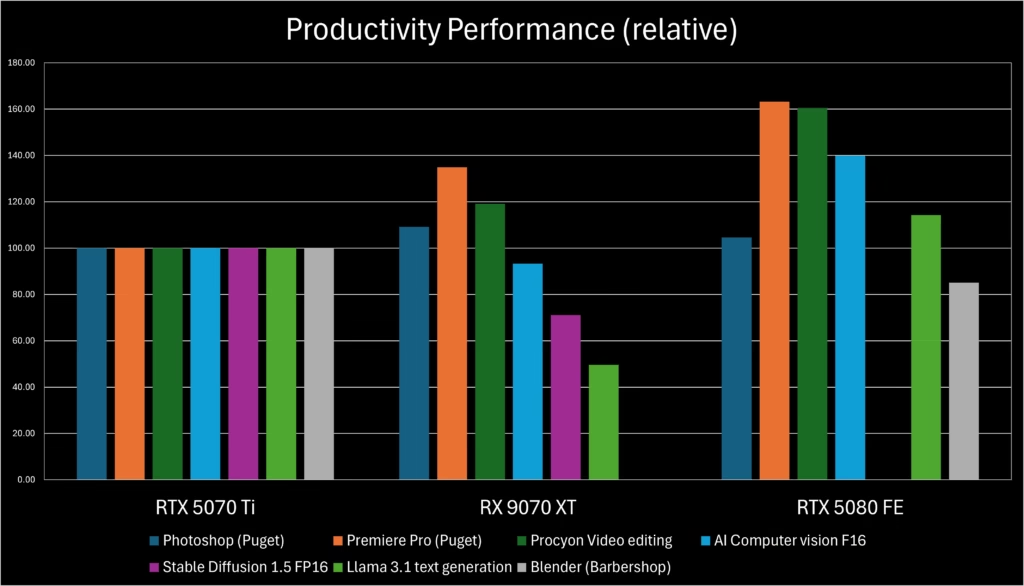
Gaming performance
As can be seen from the charts below, if you don’t care for ray-tracing and upscaling, the 5070 Ti and 9070XT are neck-and-neck in raster benchmarks. AMD’s 9070XT has a 5.5% lead at 2K, and no notable advantage at 4K. The much more expensive 5080 is only 14% faster at 2K and 18% faster at 4K.
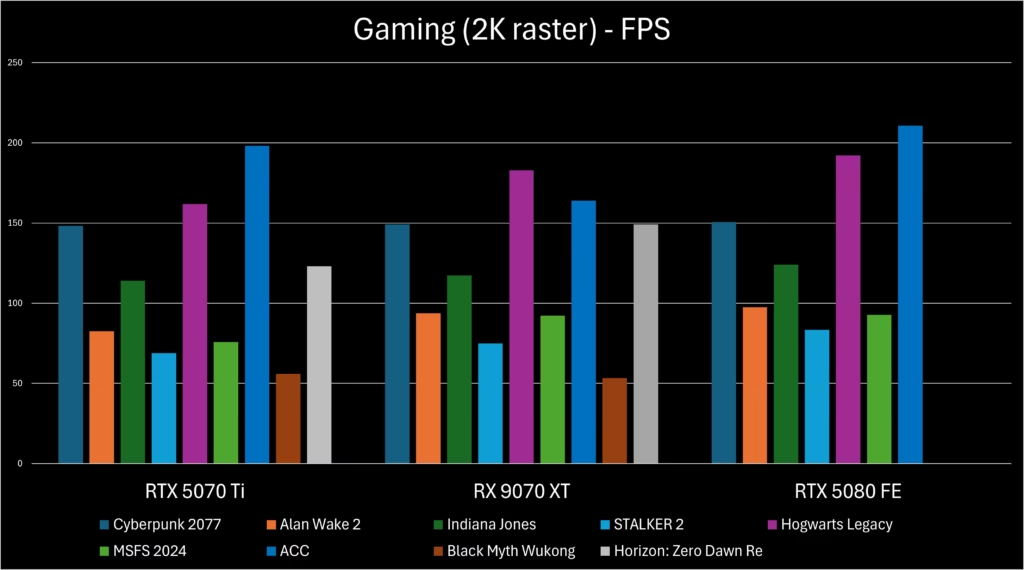
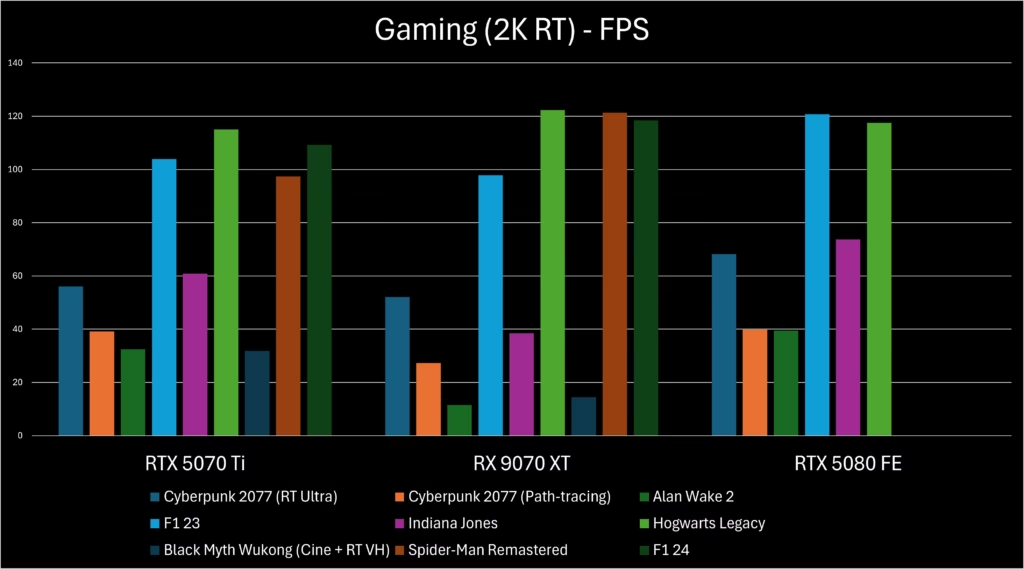
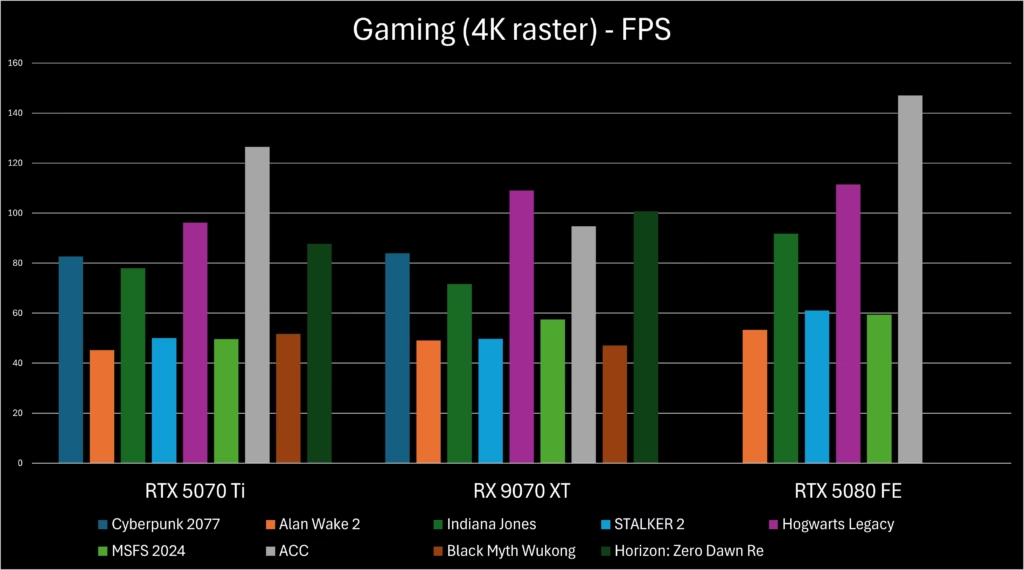
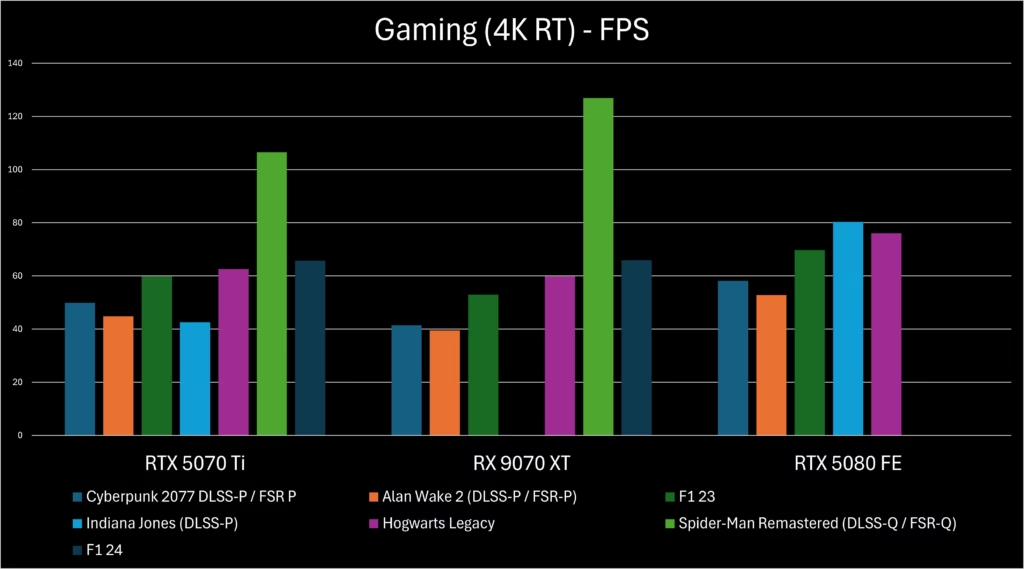
Ray-tracing, though, is a different story entirely.
When enabling high ray-tracing settings, the 9070XT is a full 30% behind overall, and drops even further behind from a subjective standpoint when you consider how far behind FSR 2 and FSR 3 upscaling techniques are compared to Nvidia DLSS 3. FSR 4 does level the playing field a bit, but too few games support FSR 4 at this point.
In addition, several games are simply unplayable (Alan Wake 2 and Black Myth Wukong, for example) on the 9070XT at 4K with RT owing to either rubbish image quality with FSR or sub-30 FPS performance. Here again the RTX 5080 is only about 14% and 18% faster at 2K and 4K respectively. While it’s not part of our test suite at the moment, it was only in the recently released Elder Scrolls IV: Oblivion remaster that I felt the need for a little more graphical horsepower, but only at 4K at max settings.
RTX 5070 Ti vs RTX 5080: They’re more similar than you realise
While the benchmarks indicate that the 5080 is faster than the 5070 Ti, I did not personally note a difference between the two cards when just playing games and not looking at frame-rates. Both cards appeared to perform similarly in even demanding titles like Cyberpunk 2077 and Alan Wake 2. If I was really looking for it, I did notice a minor increase in lag in Cyberpunk 2077 and Indiana Jones and the Great Circle when using frame-generation, but otherwise the experience was largely similar.
Considering that the Gigabyte Gaming OC RTX 5070 Ti retails at Rs 84,999 and the 5080 at 1,24,999, there is no question that the 5070 Ti is by far the better value. Given the lack of competition from AMD in this segment, the 5070 Ti stands alone in the enthusiast category.
I think the RTX 5080 is a better long-term solution only because it has more performance headroom to accommodate newer and more demanding titles. As it stands, though, the 5070 Ti is so much better value than anything else on the market that I am now deeply regretting my decision to splurge on a 5080 last month.


